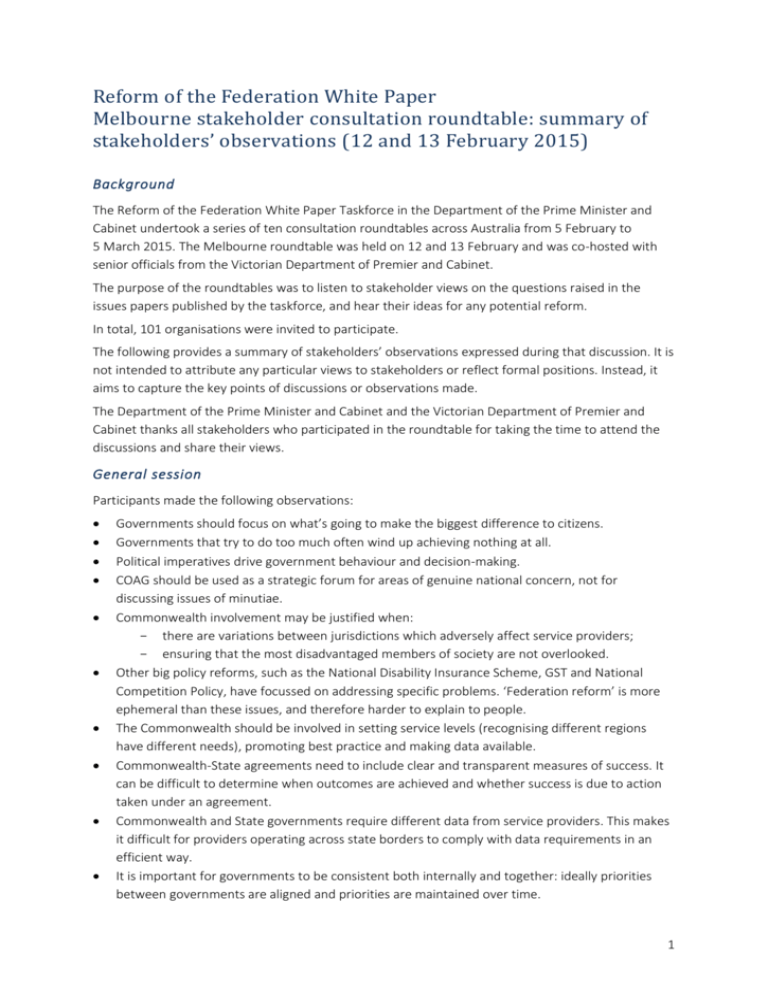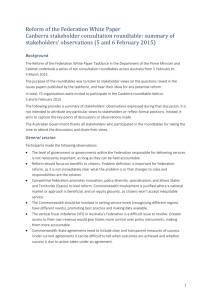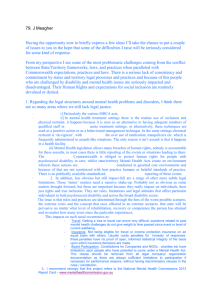DOCX 42KB - Reform of the Federation White Paper
advertisement

Reform of the Federation White Paper Melbourne stakeholder consultation roundtable: summary of stakeholders’ observations (12 and 13 February 2015) Background The Reform of the Federation White Paper Taskforce in the Department of the Prime Minister and Cabinet undertook a series of ten consultation roundtables across Australia from 5 February to 5 March 2015. The Melbourne roundtable was held on 12 and 13 February and was co-hosted with senior officials from the Victorian Department of Premier and Cabinet. The purpose of the roundtables was to listen to stakeholder views on the questions raised in the issues papers published by the taskforce, and hear their ideas for any potential reform. In total, 101 organisations were invited to participate. The following provides a summary of stakeholders’ observations expressed during that discussion. It is not intended to attribute any particular views to stakeholders or reflect formal positions. Instead, it aims to capture the key points of discussions or observations made. The Department of the Prime Minister and Cabinet and the Victorian Department of Premier and Cabinet thanks all stakeholders who participated in the roundtable for taking the time to attend the discussions and share their views. General session Participants made the following observations: Governments should focus on what’s going to make the biggest difference to citizens. Governments that try to do too much often wind up achieving nothing at all. Political imperatives drive government behaviour and decision-making. COAG should be used as a strategic forum for areas of genuine national concern, not for discussing issues of minutiae. Commonwealth involvement may be justified when: - there are variations between jurisdictions which adversely affect service providers; - ensuring that the most disadvantaged members of society are not overlooked. Other big policy reforms, such as the National Disability Insurance Scheme, GST and National Competition Policy, have focussed on addressing specific problems. ‘Federation reform’ is more ephemeral than these issues, and therefore harder to explain to people. The Commonwealth should be involved in setting service levels (recognising different regions have different needs), promoting best practice and making data available. Commonwealth-State agreements need to include clear and transparent measures of success. It can be difficult to determine when outcomes are achieved and whether success is due to action taken under an agreement. Commonwealth and State governments require different data from service providers. This makes it difficult for providers operating across state borders to comply with data requirements in an efficient way. It is important for governments to be consistent both internally and together: ideally priorities between governments are aligned and priorities are maintained over time. 1 Durability can be increased when the incentives are right. Governments could set clearer joint objectives in framing problems. Housing and Homelessness Participants made the following observations: Not all problems in housing and homelessness services could be addressed through a reallocation of roles and responsibilities within the Federation. Both levels of government hold relevant policy levers and it is important they work together. Support programmes are needed for many clients of housing and/or homelessness programmes. - Objectives of housing and homelessness programmes need to reflect the interconnectedness of housing with other issues, such as mental health, income support and employment services. Changes to policies in these and other areas have ‘spill-over’ effects into housing and homelessness. Longer term funding cycles could lead to better accountability and improved reporting requirements. The Commonwealth needs to play a national leadership role, including through the setting of targets and standards. The rates of homelessness in Australia are an indicator of the health of the nation. Australia is a large continent with a dispersed, small population. This has led to a distorted housing market. Commonwealth levers, such as immigration and income support, are affecting the demand for housing for people on low to middle incomes. The former National Housing Supply Council was a valuable, independent source of information for governments. The former COAG Select Council on Housing and Homelessness was likewise a valuable forum. The costs (such as taxes, levies and compliance costs) of investing in social housing make it an unattractive option for people seeking to make a profit. The big growth in homelessness statistics is driven by overcrowding, especially among Indigenous people. National Rental Affordability Scheme was part of the Commonwealth Government’s stimulus programme; it was an economic stimulus measure, not a housing measure. Initiatives such as social impact bonds require patience and are not conducive to short-term electoral and funding cycles; benefits will only be realised over the longer-term. The Commonwealth should play a role in gathering and disseminating information, ensuring equality, and imposing transparency around standards and performance indicators. The Commonwealth should not be involved in service delivery. Health Participants made the following observations: The health system works well for the most part, but there are a number of groups for whom it does not, including Indigenous people, people living in regional/rural/remote areas, people with complex and chronic conditions (including mental health). There needs to be better communication among health providers and health professionals. 2 There is significant potential to improve outcomes and efficiency even without role and responsibility reforms. A functioning e-health system would go some way to addressing this problem. It would also improve continuity of care. There is ‘reform fatigue’ in the health sector, and concern about the effect that changes in government at both the State and Commonwealth level affect funding and policy certainty. Momentum is lost when such changes occur, including the upcoming move from Medicare Locals to Primary Health Networks. There are specific needs in Indigenous health which are not met by mainstream services. Current funding models do not reflect the needs of individuals in the twenty-first century with chronic disease. Greater investment in preventive care and primary care would alleviate pressure on the acute sector. A more holistic view of health is needed, as it is not a stand-alone policy area. It has strong links with aged care, and in the case of mental health, strong links with housing and homelessness, and employment services. - A ‘social determinants of health’ perspective could inform this more holistic view of health. The health literacy of the community needs to improve so individuals can take greater control of their health. The Commonwealth Government should set national standards and targets, as well as have a leadership role in data collections and research. States have a useful role in trialling new approaches (e.g. casemix funding) that can later be rolled out nationally, if successful. The Commonwealth should not have a role in service delivery. Some differences in health statistics for people living in urban and regional areas (such as life expectancy) are driven by Indigenous status. Some are driven by comparatively poor access to services. Early Childhood and Schools Participants made the following observations: Child care and education should not be considered in different policy spheres. The end point of reform should be maintained across the education continuum. Education, rather than workforce participation, should be the primary focus of early childhood efforts (without sacrificing workforce outcomes). In childcare, the roll out of the National Quality Framework is a good example of the two levels of government working together for the benefit of children and families. It has however, increased costs which has had flow on effects for workforce participation. In general states should lead on schools policy. The Commonwealth should focus on teacher quality; everything else should be left to the States. A degree of overlap in roles and responsibilities can allow for policy innovation. The Commonwealth should continue to play a role in national standard setting, however there is scope for better collaboration to ease overlap and duplication. 3 Durability of financial arrangements is important. Service providers need certainty so they can plan effectively for the following year. Funding arrangements and regulation must be consistent across sectors to encourage greater competition. Red tape should be removed where possible. This could include harmonising regulation and reporting requirements. Both the Commonwealth and the States should be involved in funding schools, particularly for the non-government sector. The Commonwealth’s role should be to fund parent choice. A ‘needs based’ funding model similar to the funding model introduced for schools funding, could be extended to cover preschool (as occurs in New South Wales). In schools, the current national architecture works and should be given a chance to succeed. Schools should be given more independence accompanied by stronger governance. Schools should be able to decide how they meet minimum standards. Current governance arrangements do not always encourage this level of independence. Training for local school councils could result in improved performance. Equity considerations should be the main focus of reform. The level of government support and funding for children with disabilities should be the same regardless of the sector/school chosen. Incentives are needed to get highly skilled teachers to the areas of most need. Vocational Education and Training (VET) and Higher Education Participants made the following observations: The Commonwealth should retain a role in VET; it shouldn’t just be left to the States. States have a useful role in trialling new approaches (e.g. demand-driven VET funding) that can improve the VET systems over time. There is already some level of reform fatigue particularly in the VET sector. Post-secondary training and education should be a national/seamless system, suggesting a definite role for the Commonwealth in VET, particularly in apprenticeships, international training, funding and regulation. National firms find the differences in the eight State training systems frustrating. Apprenticeships are an area where something could be done nationally and this approach could be facilitated through an apprenticeships commission with oversight/management of a national system. VET has become a market but contestability of funding is making it a “nightmare” and a “free for all” amongst providers. The national/local issue in VET can be overstated. For example, the current situation with the car industry in Victoria and South Australia doesn’t just affect those States and is broader than just local labour market needs. Both the Commonwealth and the State have their own initiatives to support training and these often have the same objectives but different rules. Registered training organisations (RTOs) respond by considering what programs suit them best. VET plays an important role for disadvantaged students. However, the level and nature of support provided by governments, particularly for disadvantaged students, is very different across Australia. The Commonwealth’s national reach means that it is the appropriate level of government to address equity issues and it could play a greater role in this area. Access and equity issues could be addressed through a more even entitlement or measures such as the Gonski schools funding model. 4 While there is increasing overlap between elements of VET and higher education, including in financial support arrangements, the socio-economic profiles of the student cohorts are not identical. Many Indigenous students are unable to take advantage of access to funding support because they have already participated in numerous training programmes without gaining employment. These students can’t choose another area of training because the rules only allow for upskilling to a higher qualification. The funding arrangements for higher education are clear. The role of the States in regulation, on the other hand, doesn’t reflect their relationship with universities and the Commonwealth wears the financial risk. Commonwealth and State regulation is duplicative or competing (even within the same level of government) and there needs to be nationally consistent reporting requirements. States currently have a role in governance (decisions about council members etc.) and in the sale of assets and some of the governance requirements are onerous. The principle of subsidiarity could be applied in this area so that universities are given the autonomy to govern and manage their own affairs (i.e. the Commonwealth shouldn’t be given these roles). While there are clear differences between how VET and higher education are delivered; there is an overlap between the sectors with non-university higher education providers. These providers are more like VET and higher education courses are often delivered by the same person delivering VET qualifications. 5







